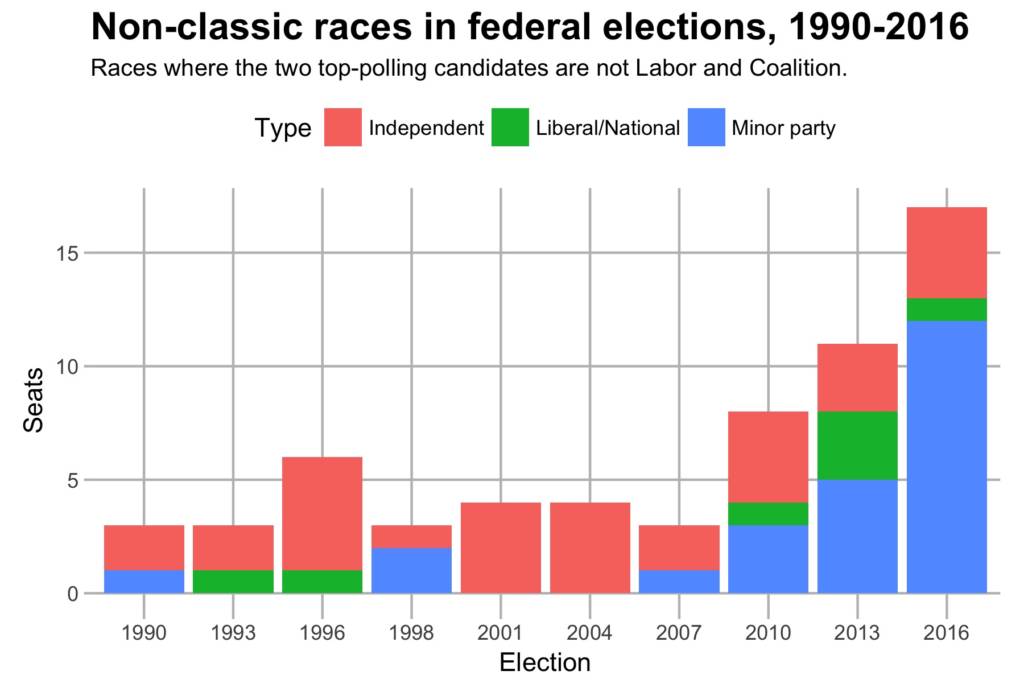NSW state politics appears to be shifting away from a conventional Labor-Coalition contest, with different kinds of contests dominating in different regions.
While there has been a general trend in Australian politics away from conventional Labor-Coalition contests and towards races which feature an independent or minor party in the final count (what the Australian Electoral Commission calls “non-classic”), NSW has led the crowd.
There’s reason to think this trend will go further in 2019, and has interesting implications for how the NSW state election will play out in different regions.
This chart shows the number of non-classic races in NSW since 1988:
The number of these seats was largely steady from 1988 to 2003 (barring 1995) before climbing in 2007 and 2011, and returning to the norm in 2015.
But while there has been some long-term consistency, the overall level is much higher than in other jurisdictions.
This chart shows the same information for federal seats since 1990. It’s a chart I produced for my chapter in the Double Disillusion book.

Non-classic races in the federal arena reached eleven in 2013 and seventeen in 2016, including a number of Liberal/Nationals contests (none of which have taken place in NSW since 1988). But with about 60% more seats, it translates to a lot less seats as a proportion. Non-classic seats made up 11% of seats at the 2016 federal election, compared to 29% at the 2011 NSW state election.
I have also collected the same information from the last two state elections in three other states, and the last five elections in Queensland (all based on data available in my data repository for website patrons).
| State | Election | Non-classic | Total seats | Proportion |
| QLD | 2004 | 8 | 89 | 9.0 |
| QLD | 2006 | 7 | 89 | 7.9 |
| QLD | 2009 | 6 | 89 | 6.7 |
| QLD | 2012 | 18 | 89 | 20.2 |
| QLD | 2015 | 7 | 89 | 7.9 |
| QLD | 2017 | 28 | 93 | 30.1 |
| SA | 2014 | 3 | 47 | 6.4 |
| SA | 2018 | 12 | 47 | 25.5 |
| VIC | 2014 | 7 | 88 | 8.0 |
| VIC | 2018 | 15 | 88 | 17.0 |
| WA | 2013 | 3 | 59 | 5.1 |
| WA | 2017 | 8 | 59 | 13.6 |
Only one NSW state election in the last three decades had less than 10% of seats being non-classic, but this was the norm for many other state elections.
The Queensland state election in 2017 produced a lot of non-classic seats because of One Nation. Likewise the 2018 South Australian election because of SA Best, and Queensland 2012 because of Katter’s Australian Party.
At the 2011 state election, there was a big surge in part because of the north shore – the Greens outpolled Labor in every seat across this region, even though it did not get them at all close to winning any seats.
What is interesting about the 2019 election is that we’re expecting a lot of non-classic races, but not because of a single party. The Greens will come in the top two in a handful of inner-city seats, and possibly some seats on the north coast. There are also expectations that a large batch of independents will come in the top two, and we also expect the Shooters, Fishers and Farmers to come in the top two in some seats in inland NSW.
Antony Green decided not to produce a Legislative Assembly calculator for this election, primarily because he doesn’t expect the statewide two-party-preferred vote to have enough of a relationship to individual seats.
So we are facing an election which will likely play out very differently in different areas: conventional Labor-Liberal races on the suburban fringe, Greens contests in the inner city and the north coast, Shooters and independent races in western NSW.
If the minor parties and independents perform well this could result in quite a large and diverse crossbench. It’s not inconceivable that we could end up in a situation where either a block of Greens or a block of Shooters and independents could hold the balance of power in the lower house. But even if that doesn’t happen, it will certainly make for more complex and diverse election results.



Curiously the Tasmanian Legislative Council is moving in the other direction, having had what I believe to be its first ever *classic* 2PP contest in the Pembroke by-election 2017 and then another one in Prosser 2018. There could also be classic 2PP contests in two of the three up for grabs this year (Labor seems not to be running in Nelson.)
Comments are closed.